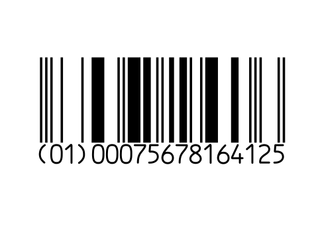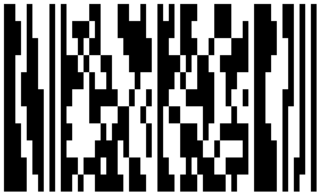Related Research Articles

The Universal Product Code is a barcode symbology that is used worldwide for tracking trade items in stores.

A barcode or bar code is a method of representing data in a visual, machine-readable form. Initially, barcodes represented data by varying the widths, spacings and sizes of parallel lines. These barcodes, now commonly referred to as linear or one-dimensional (1D), can be scanned by special optical scanners, called barcode readers, of which there are several types.

A barcode reader or barcode scanner is an optical scanner that can read printed barcodes, decode the data contained in the barcode on a computer. Like a flatbed scanner, it consists of a light source, a lens, and a light sensor for translating optical impulses into electrical signals. Additionally, nearly all barcode readers contain decoder circuitry that can analyse the barcode's image data provided by the sensor and send the barcode's content to the scanner's output port.

PDF417 is a stacked linear barcode format used in a variety of applications such as transport, identification cards, and inventory management. "PDF" stands for Portable Data File. The "417" signifies that each pattern in the code consists of 4 bars and spaces in a pattern that is 17 units (modules) long. The PDF417 symbology was invented by Dr. Ynjiun P. Wang at Symbol Technologies in 1991. It is defined in ISO 15438.

Code 128 is a high-density linear barcode symbology defined in ISO/IEC 15417:2007. It is used for alphanumeric or numeric-only barcodes. It can encode all 128 characters of ASCII and, by use of an extension symbol (FNC4), the Latin-1 characters defined in ISO/IEC 8859-1. It generally results in more compact barcodes compared to other methods like Code 39, especially when the texts contain mostly digits. Code 128 was developed by the Computer Identics Corporation in 1981.

A QR code is a type of two-dimensional matrix barcode, invented in 1994, by Japanese company Denso Wave for labelling automobile parts. A QR code consists of black squares arranged in a square grid on a white background, including some fiducial markers, which can be read by an imaging device, such as a camera, and processed using Reed–Solomon error correction until the image can be appropriately interpreted. The required data are then extracted from patterns that are present in both the horizontal and the vertical components of the QR image.

A Data Matrix is a two-dimensional code consisting of black and white "cells" or dots arranged in either a square or rectangular pattern, also known as a matrix. The information to be encoded can be text or numeric data. Usual data size is from a few bytes up to 1556 bytes. The length of the encoded data depends on the number of cells in the matrix. Error correction codes are often used to increase reliability: even if one or more cells are damaged so it is unreadable, the message can still be read. A Data Matrix symbol can store up to 2,335 alphanumeric characters.

GS1 is a not-for-profit, international organization developing and maintaining its own standards for barcodes and the corresponding issue company prefixes. The best known of these standards is the barcode, a symbol printed on products that can be scanned electronically.

The International Article Number is a standard describing a barcode symbology and numbering system used in global trade to identify a specific retail product type, in a specific packaging configuration, from a specific manufacturer. The standard has been subsumed in the Global Trade Item Number standard from the GS1 organization; the same numbers can be referred to as GTINs and can be encoded in other barcode symbologies defined by GS1. EAN barcodes are used worldwide for lookup at retail point of sale, but can also be used as numbers for other purposes such as wholesale ordering or accounting. These barcodes only represent the digits 0–9, unlike some other barcode symbologies which can represent additional characters.
Mobile tagging is the process of providing data read from tags for display on mobile devices, commonly encoded in a two-dimensional barcode, using the camera of a camera phone as the reader device. The contents of the tag code is usually a URL for information addressed and accessible through Internet.

The GS1 Databar Coupon code has been in use in retail industry since the mid-1980s. At first, it was a UPC with system ID 5. Since UPCs cannot hold more than 12 digits, it required another barcode to hold additional information like offer code, expiration date and household ID numbers. Therefore, the code was often extended with an additional UCC/EAN 128 barcode. EAN 13 was sometimes used instead of UPC, and because it starts with 99, it was called the EAN 99 coupon barcode, and subsequently GS1 DataBar. After more than 20 years in use, there is now a need to encode more data for complex coupons, and to accommodate longer company IDs, so the traditional coupon code has become less efficient and sometimes not usable at all.

ZBar is an open-source C barcode reading library with C++, Python, Perl, and Ruby bindings. It is also implemented on Linux and Microsoft Windows as a command-line application, and as an iPhone application.

The application Barcode Scanner is an Android app, from the open-source project ZXing, that allows an Android device with imaging hardware to scan barcodes or 2D barcodes and retrieve the data encoded. Information encoded often includes web addresses, geographical coordinates, and small pieces of text, in addition to commercial product codes. This Android-based system has similar functionality to a hardware barcode reader.

David Jarrett Collins was an inventor and businessman whose career was focused on bringing barcode technology into the mainstream. While at Sylvania in 1960, he led a team that developed the first functional barcode system for tracking railroad cars, and subsequently worked on developing laser barcode systems.

Codablock is a family of stacked 1D barcodes which was invented in Identcode Systeme GmbH in Germany in 1989 by Heinrich Oehlmann. Codablock barcodes are based on stacked Code 39 and Code 128 symbologies and have some advantages of 2D barcodes.

Matrix 2 of 5 is a variable length, discrete, two width symbology. Matrix 2 of 5 is a subset of two-out-of-five codes. Unlike Industrial 2 of 5 code, Matrix 2 of 5 can encode data not only with black bars but with white spaces.

MicroPDF417 is two-dimensional (2D) stacked barcode symbology invented in 1996, by Frederick Schuessler, Kevin Hunter, Sundeep Kumar and Cary Chu from Symbol Technologies company. MicroPDF417 consists from specially encoded Row Address Patterns (RAP) columns and aligned to them Data columns encoded in "417" sequence which was invented in 1990. In 2006, the standard was registered as ISO/IEC 24728:2006.

Han Xin code is two-dimensional (2D) matrix barcode symbology invented in 2007 by Chinese company The Article Numbering Center of China to break monopoly of QR code. As QR code, Han Xin code consists of black squares and white square spaces arranged in a square grid on a white background. It has four finder patterns and other markers which allow to recognize it with camera-based readers. Han Xin code contains Reed–Solomon error correction with ability to read corrupted images. At this time, it is issued as ISO/IEC 20830:2021.

DotCode is two-dimensional (2D) matrix barcode invented in 2008 by Hand Held Products company to replace outdated Code 128. At this time, it is issued by Association for Automatic Identification and Mobility (AIM) as “ISS DotCode Symbology Specification 4.0”. DotCode consists of sparse black round dots and white spaces on white background. In case of black background round dots, creating barcode, can be white. DotCode was developed to use with high-speed industrial printers where printing accuracy can be low. Because DotCode by the standard does not require complicated elements like continuous lines or special shapes it can be applied with laser engraving or industrial drills.

Rectangular Micro QR Code is two-dimensional (2D) matrix barcode invented and standardized in 2022 by Denso Wave as ISO/IEC 23941. rMQR Code is designed as a rectangular variation of QR code and has the same parameters and applications as original QR code. But rMQR Code is more suitable for the rectangular areas and has difference between width and height up to 19 in R7x139 version. In this way it can be used in places where 1D barcodes are used. rMQR Code can replace Code 128 and Code 39 barcodes with more effective data encoding.
References
- ↑ "Barcodes vs RFID, Why Barcodes Still Win". www.brightpearl.com. 17 August 2018.
- ↑ Canteli, Ana (28 February 2020). "Barcode in document management". www.openkm.com.
- ↑ "Barcodes help make your business processes more efficient". processflows.co.uk. Archived from the original on 2021-01-17.
- ↑ "DHL shipment tracking labels". www.dhl.com.
- ↑ "USPS Tracking Barcode and Label Changes". www.endicia.com.
- ↑ Samara, Anatoliy; Hofmann, Klaus Michael; Groten, Dirk (4 September 2014). "Patent US 2014/0247278 A1 Barcode visualization in augmented reality" (PDF). United States Patent Application Publication.
- ↑ Palladino, Tommy (11 February 2018). "Walmart Turns Its iPhone App's Barcode Scanner into an Augmented Reality Price Comparison Tool". mobile-ar.reality.news.
- ↑ "PrintBar II Barcode printing software". books.google.com. ISSN 0888-8507, PC Mag, August 1989 p.464. August 1989.
- ↑ "Bar Code Software for Windows". books.google.com. ISSN 0888-8507, PC Mag, 8 November 1994 p.414. 8 November 1994.
- ↑ "LabelWorks for Windows". books.google.com. ISSN 0199-6649, InfoWorld Vol.17, №43 p.104. 23 October 1995.
- ↑ "Bar Code Fonts for Windows". books.google.com. ISSN 0888-8507, PC Mag Vol.16, № 21. 2 December 1997.
- ↑ "Bar Code Readers for IBM PC, Mac, and RS232 Terminals". books.google.com. ISSN 0888-8507, PC Mag Vol.16, № 21. 2 December 1997.
- ↑ "AIM Specifications (ISS)". www.aimglobal.org.
- ↑ "Standards by ISO/IEC JTC 1/SC 31 Automatic identification and data capture techniques". www.iso.org.
- ↑ "MacroPDF417 Barcodes". www.barcodefaq.com.
- ↑ "ZBar bar code reader. How does it work?". zbar.sourceforge.net.
- ↑ Rocholl, Johann C.; Klenk, Sebastian; Heidemann, Gunther. "Robust 1D Barcode Recognition on Mobile Devices" (PDF). 2010 International Conference on Pattern Recognition.
- ↑ Adelmann, Robert; Langheinrich, Marc; Flörkemeier, Christian. "Toolkit for Bar Code Recognition and Resolving on Camera Phones – Jump Starting the Internet of Things" (PDF). European Mathematical Information Service. S2CID 1050073.
- ↑ Katona, Melinda; Bodńar, Ṕeter; Nýul, Ĺaszĺo G. "Distance Transform and Template Matching BasedMethods for Localization of Barcodes and QR Codes" (PDF).
- ↑ Hansen, Daniel Kold; Nasrollahi, Kamal; Rasmusen, Christoffer B; Moeslund, Thomas B. "Real-Time Barcode Detection and Classification using Deep Learning" (PDF).
- ↑ Trewe, Marti (4 June 2012). "QR codes work best in magazines, newspapers". theamericangenius.com}.
- ↑ Baruah, Basant (13 April 2020). "Augmented reality and QR codes – What you need to know". blog.beaconstac.com.
- ↑ "Launch of the QR-bill in Switzerland". www.six-group.com. 9 June 2020.
- ↑ "QR code design & use". www.prepressure.com.
- ↑ "International drivers license. Booklet and plastic card". www.idlid.com.
- ↑ "Han Xin Code". www.ancc.org.cn. Archived from the original on 2020-04-02.
- ↑ "How to Make your Business Card Better with QR Codes". covve.com.
- ↑ "Scanning Automobile VIN Bar Codes". www.barcodehq.com.
- ↑ "Aspose.BarCode On Premise APIs". www.aspose.com.
- ↑ "MSDN Magazine V32 N8, Aspose.BarCodeA complete toolkit for barcode generation and recognition" (PDF). Microsoft. August 2017. p. 99.
- ↑ "Barcode Writer in Pure PostScript". bwipp.terryburton.co.uk.
- ↑ "Symbologies Reference". github.com.
- ↑ "Welcome to Barcode4J". sourceforge.net.
- ↑ "Preview of all supported barcode symbologies by Barcode4J". sourceforge.net.
- ↑ "Barcode Encoder & Decoder Components for .NET & Java developers". www.barcodelib.com.
- ↑ barkoder.com. "Barcode Scanner SDK for all Enterprise mobile solutions". barkoder. Retrieved 2023-10-26.
- ↑ "BarCode Reader SDK reads barcodes from scanned documents and images". bytescout.com. 10 August 2010.
- ↑ "ClearImage Barcode Reader SDK". www.inliteresearch.com.
- ↑ "Barcode Scanner SDK & API". manateeworks.com.
- ↑ "Docutain Barcode Scanner SDK". sdk.docutain.com.
- ↑ "Barcode Recognition SDK - DTK Software". www.dtksoft.com.
- ↑ "Dynamsoft Barcode Reader SDK". www.dynamsoft.com. 21 December 2021.
- ↑ "GdPicture.NET Barcode SDK for 1D & 2D Barcode Reading & Writing". www.gdpicture.com.
- ↑ "GdPicture.NET: More than 100 Document Formats Supported". www.gdpicture.com.
- ↑ "GNU Barcode". www.gnu.org.
- ↑ "IBscanner for .NET". www.ibscanner.com.
- ↑ "Barcode Generation Solutions for Business Automation". www.idautomation.com.
- ↑ "Barcode Fonts". www.idautomation.com.
- ↑ "Barcode Components". www.keepdynamic.com.
- ↑ "Barcode SDK Technology". www.leadtools.com.
- ↑ "Barcode Scanning, ML Kit, Google Developers". developers.google.com.
- ↑ "Google APIs Terms of Service". google.com.
- ↑ "Barcode, Labeling, Printing & Imaging components". neodynamic.
- ↑ "Barcode Symbologies". www.neodynamic.com.
- ↑ "Recognize, Read and Decode Barcodes from Images". www.neodynamic.com.
- ↑ "The barcodes". grandzebu.net.
- ↑ "World Leading .NET SDK for Barcode Scanning and Reading". www.pqscan.com.
- ↑ "Python Barcode Library". github.com. 8 August 2022.
- ↑ "Barcode Scanner SDK". scanbot.io.
- ↑ "Barcode Reader SDK for Windows". www.sd-toolkit.com.
- ↑ "The industry leading Barcode SDK". www.technoriversoft.com.
- ↑ ".NET Barcode Library - Generate, Read and Scan 1D 2D Barcode Images". www.e-iceblue.com.
- ↑ "Supports rich Barcode type, more than 39 different barcodes". www.e-iceblue.com.
- ↑ "TBarCode SDK - Barcode Generator Software". www.tec-it.com.
- ↑ "TBarCode SDK Data Sheet & Barcode Overview". www.tec-it.com.
- ↑ "VintaSoft Barcode .NET SDK". www.vintasoft.com.
- ↑ "Read barcodes from PDF document". www.vintasoft.com.
- ↑ "Powerful Barcode Decoder SDK - Viziotix". www.viziotix.com.
- ↑ "Expert barcode scanner SDK for smartphones, robots, drones and cameras" (PDF). www.viziotix.com.
- ↑ "VS BARCODE READER". visionsmarts.com.
- ↑ "ZBar bar code reader". sourceforge.net.
- ↑ "Zen Barcode Rendering Framework". github.com. 6 January 2023.
- ↑ "Zint Barcode Generator". sourceforge.net.
- ↑ "ZintNET is a .NET port of the popular Zint Library written in C#". sourceforge.net.
- ↑ "Okapi Barcode". github.com. 30 December 2022.
- ↑ "Zint Barcode Generator and Zint Barcode Studio User Manual Introduction". www.zint.org.uk.
- ↑ "Zint Barcode Generator and Zint Barcode Studio User Manual Types of symbology". www.zint.org.uk.
- ↑ "ZXing ("Zebra Crossing") barcode scanning library for Java, Android". github.com. 12 January 2023.
- ↑ "Automatic Identification and Data Capturing (AIDC) Technology". www.elprocus.com. ElProCus is an educational website on electronic projects for ECE and EEE students. 6 June 2014.
- ↑ "History of Barcodes". barcodeguide.seagullscientific.com. BarTender by Seagull Scientific.
- ↑ "History of the Barcode Scanner". www.dbk.com. Refurbished IT Solutions. Archived from the original on 2022-04-23.
- ↑ "What is the most efficient barcode to use?". www.barcodefaq.com. Barcode Information Tutorials.
- ↑ "Barcoding – getting it right Recommendations for best practice by GS1 UK" (PDF). www.gs1uk.org. GS1 UK The Global Language of Business.
- ↑ "Best practices for improving the quality of Bar codes at the Point-of sale" (PDF). www.gs1.at. GS1 Austria.
- ↑ "Error correction makes a big difference in the choice of 1D vs. 2D barcoding". www.supplychainservices.com. 4 December 2014. Archived from the original on 2022-03-30.
- ↑ "Understanding the Value of 2D Barcodes". www.maibpo.com. Archived from the original on 2020-07-11.
- ↑ "3 Ways that 2D Barcodes Increase Warehouse Efficiency". lowrysolutions.com. 4 October 2016.
- ↑ "DMRE". www.e-d-c.info. Retrieved 2021-12-16.

